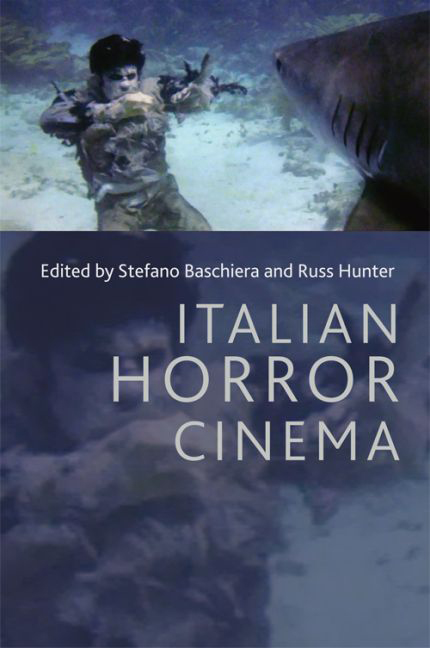Book contents
- Frontmatter
- Contents
- List of figures
- List of contributors
- Acknowledgements
- Introduction
- 1 Preferisco l'inferno: early Italian horror cinema
- 2 Domestic films made for export: modes of production of the 1960s Italian horror film
- 3 The 1980s Italian horror cinema of imitation: the good, the ugly and the sequel
- 4 Knowing the unknown beyond: ‘Italianate’ and ‘Italian’ horror cinema in the twenty-first century
- 5 Bavaesque: the making of Mario Bava as Italian horror auteur
- 6 The Argento Syndrome: aesthetics of horror
- 7 Scrap metal, stains, clogged drains: Argento's refuse and its refusals
- 8 The giallo /slasher landscape: Ecologia del delitto, Friday the 13th and subtractive spectatorship
- 9 Kings of terror, geniuses of crime: giallo cinema and fumetti neri
- 10 Political memory in the Italian hinterland: locating the ‘rural giallo’
- 11 The horror of progressive rock: Goblin and horror soundtracks
- 12 ‘The only monsters here are the filmmakers’: animal cruelty and death in Italian cannibal films
- 13 Italian horror cinema and Italian film journals of the 1970s
- Index
4 - Knowing the unknown beyond: ‘Italianate’ and ‘Italian’ horror cinema in the twenty-first century
Published online by Cambridge University Press: 12 September 2017
- Frontmatter
- Contents
- List of figures
- List of contributors
- Acknowledgements
- Introduction
- 1 Preferisco l'inferno: early Italian horror cinema
- 2 Domestic films made for export: modes of production of the 1960s Italian horror film
- 3 The 1980s Italian horror cinema of imitation: the good, the ugly and the sequel
- 4 Knowing the unknown beyond: ‘Italianate’ and ‘Italian’ horror cinema in the twenty-first century
- 5 Bavaesque: the making of Mario Bava as Italian horror auteur
- 6 The Argento Syndrome: aesthetics of horror
- 7 Scrap metal, stains, clogged drains: Argento's refuse and its refusals
- 8 The giallo /slasher landscape: Ecologia del delitto, Friday the 13th and subtractive spectatorship
- 9 Kings of terror, geniuses of crime: giallo cinema and fumetti neri
- 10 Political memory in the Italian hinterland: locating the ‘rural giallo’
- 11 The horror of progressive rock: Goblin and horror soundtracks
- 12 ‘The only monsters here are the filmmakers’: animal cruelty and death in Italian cannibal films
- 13 Italian horror cinema and Italian film journals of the 1970s
- Index
Summary
Since the year 2000, European horror cinema has undergone a major revival. After the 1990s, which saw very few European horror films made, the first fifteen years of the twenty-first century witnessed a groundswell in production from France, Germany, the Netherlands, Spain, Serbia and the UK. Italy was also part of this ‘new wave’, though its horror films typically did not reach as wide an audience, nor experience the critical recognition, of its continental neighbours. Italian horror during this period also faced a great irony. Whereas several filmmakers from America and Europe pastiched the Italian horror boom of the 1960s, 1970s and 1980s with films that were widely distributed and commercially well received, Italian directors shooting horror films either in Italy or elsewhere typically lacked access to ‘formal’ distribution (Lobato, 2012) and therefore their films were not as widely seen.
It is the purpose of this chapter to explore what ‘Italian horror’ has meant in the twenty-first century as a historically grounded and transnational concept on the one hand, and a contemporaneous mode of production on the other. The chapter begins by considering those films that, while lacking the involvement of Italian resources and investors, set out explicitly to recall some of the most influential moments of Italian horror cinema's history. It will consider, specifically, how such films – what I will be collectively referring to as ‘Italianate’ horror – can be considered as both ‘art’ and ‘exploitation’. The chapter will then proceed to consider the shape of Italian horror production since 2000, and how it managed to stay buoyant in a marketplace crowded with high-profile international production.
ITALIANATE HORROR
The term ‘Italianate’ is often used to refer to ‘Italian-style’ architecture dating back to the 1840s, which was popular in both America and England and drew inspiration from ‘Tuscan late-Medieval farmhouses’ (Hopkins, Jr, 2009: 102). The use of the term can also be found in various books dealing with early nineteenth-century English fashion (Brand, 2011: ix), and late nineteenth- to early twentieth-century works of art (Jaffe, 1992). However, in spite of its implied lack of currency in the twenty-first century, the presence of what C. P. Brand in 1957 dubbed ‘Italo-mania’ (2011: ix) has been widely felt across international film production in recent years: firstly, across the field of horror and exploitation cinema; and secondly, in the realm of art cinema.
- Type
- Chapter
- Information
- Italian Horror Cinema , pp. 62 - 78Publisher: Edinburgh University PressPrint publication year: 2016



